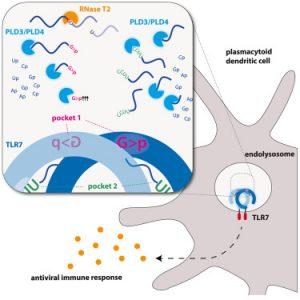Toll-like receptor 7 (TLR7), critical within our immune system, stands guard against viruses. Located in dendritic cells, TLR7 detects single-stranded viral RNA, triggering the release of immune messengers that activate our defences. Understanding TLR7’s activation mechanism is crucial, as malfunctions can contribute to autoimmune diseases. New research sheds light on the intricate interplay of enzymes surrounding TLR7 (Figure 1).
We know TLR7 recognizes foreign RNA, but how exactly does it process these molecules for recognition? Prior research suggested that RNA needed to be fragmented for TLR7 to detect it. This new study, employing a diverse array of techniques, unveils the intricate steps involved in this process.
Evolution has equipped our immune system to identify pathogens by their genetic material. TLR7 specifically targets viral RNA, long strands that require processing for detection. Enter nucleases – molecular scissors that chop these RNA strands into smaller pieces. Endonucleases act like regular scissors, cleaving the RNA internally, while exonucleases chew away from the ends. This teamwork generates RNA snippets that can bind to two specific pockets on the TLR7 receptor.
The study revealed that RNA recognition by TLR7 relies on the combined action of the endonuclease RNase T2 and the exonucleases PLD3 and PLD4 (phospholipase D3 and D4). Interestingly, the researchers discovered that PLD exonucleases play a double role within immune cells. They have a pro-inflammatory effect when interacting with TLR7 but exhibit an anti-inflammatory effect with another receptor, TLR9. This ability to both promote and inhibit inflammation might be a crucial safeguard to prevent immune system imbalances.
By deciphering the complex interplay of enzymes around TLR7, researchers gain valuable insights into viral defence mechanisms. This knowledge can pave the way for the development of novel therapeutic strategies to modulate TLR7 activity and potentially combat viral infections and autoimmune diseases.
Journal article: Marleen Bérouti, M., et al., 2024. Lysosomal endonuclease RNase T2 and PLD exonucleases cooperatively generate RNA ligands for TLR7 activation. Immunity.
Summary by Stefan Botha

